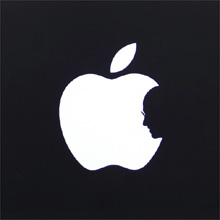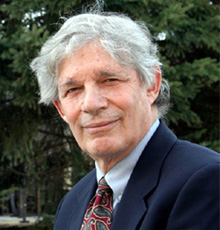October 10, 2011
Steve Jobs and Creativity

There have been a great many creative and inventive people in history but most have not told us how they did it. Isaac Newton gave a hint when he said: "If I have seen further it is only by standing on the shoulders of giants." Jared Diamond, who has studied human evolution, says that opportunity, not necessity, is the mother of invention. Ecclesiastes 1:9 says:
What has been will be again,Yet we keep making progress. And nature, specially the biosphere, evolves. We keep inventing things. How does it happen? We are very lucky in that Steve Jobs in his product introductions shows us how creativity works in practice, at least he shows us the tip of the iceberg. And the story he told about calligraphy during his Stanford commencement address is also about how creativity works in practice.
what has been done will be done again;
there is nothing new under the sun.
Before analyzing Jobs's work I want to lay some background, first a scientific view of progress and creativity, second the method of a very successful practitioner in the military, and third a poignant example by a young graphic designer. I think this background adds relevance to the analysis of Jobs's own creativity.
The Adjacent Possible

Stuart Kauffman
Stuart Kauffman, a biologist and my favorite Complexity scientist, has thought about possible laws that govern the evolution of biospheres. One of them is the idea of the adjacent possible:
It just may be the case that biospheres on average keep expanding into the adjacent possible. By doing so they increase the diversity of what can happen next. It may be that biospheres, as a secular trend, maximize the rate of exploration of the adjacent possible.The way I understand this is that instead of giant leaps we make progress step by step by going from here to the next stepping stone. Maybe the difference between a visionary and an ordinary mortal is the size of the step each is able to take.
Destruction and Creation (Analysis and Synthesis)

Forty Second Boyd
Boyd described his method of innovation in the briefing titled "Destruction and Creation"
Illustration:This is not a serendipitous discovery. It's is a mental process designed to explore the adjacent possible which Boyd then used as a basis for his military doctrine, the OODA (Observe, Orient, Decide, and Act) Loop. The presentation continues:
-Imagine that you are on a ski slope with other skiers-retain this image.
-Imagine that you are in Florida riding in an outboard motorboat-maybe even towing water-skiers-retain this image.
-Imagine that you are riding a bicycle on a nice spring day-retain this image.
-Imagine that you are a parent taking your son to a department store and that you notice he is fascinated by the tractors or tanks with rubber caterpillar treads-retain this image.
Now imagine that you:
-Pull skis off ski slope; discard and forget rest of image.
-Pull outboard motor out of motorboat; discard and forget rest of image.
-Pull handlebars off bicycle; discard and forget rest of image.
-Pull rubber treads off toy tractors or tanks; discard and forget rest of image.
This leaves us with:
Skis, outboard motor, handlebars, rubber treads
Pulling all this together
What do we have?
Snowmobile
? What does this example suggest ?Quite independently and probably before Kauffman invented the term "adjacent possible," Boyd has given us a practical application of it. This should not come as a surprise, despite the fact that specialists have their own little boxes, neither Kauffman nor Boyd accepted being boxed in. Both are exemplars of the Renaissance Man living on the cutting edge.
To discern what is going on we must interact in a variety of ways with our environment.
In other words
We must be able to examine the world from a number of perspectives so that we can generate mental images or impressions that correspond to that world.
More to the point
We will use this scheme of pulling things apart (analysis) and putting them back together (synthesis) in new combinations to find how apparently unrelated ideas and actions can be related to one another.

Jonathan Mak's Tribute to Steve Jobs
Jonathan Mak has given us a wonderful and timely example of "Destruction and Creation." Paraphrasing Colonel Boyd:-Imagine the multicolored Apple logo-retain this imageTwenty five years ago, when we were developing software for Mac, my graphic designer came up with a logo that incorporated the mouse image from Mac's packaging. My Silicon Valley lawyer said we might get into trouble with Apple over copyright or trade mark violations. Be that as it may, this is how innovation happens, by invading the adjacent possible.
-Imagine a profile portrait of Steve Jobs-retain this image
-Pull the silhouette off the Apple logo; discard and forget rest of image.
-Pull the silhouette off Jobs's portrait; discard and forget rest of image.
-Put the two silhouettes together
Serendipity and Intelligent Design
There is an ongoing debate between theists and atheists regarding "intelligent design." Theists hold that our wonderful universe could not have happened by chance, that an intelligent designer was required. Atheist hold that the universe evolved without direction, that competition and Darwinian selection picked the winners. In technological innovation purposeful R&D plays a critical role but serendipity should not be ignored. Some of the best labs in the world give researchers time to work on projects of their own with excellent results.There are hundreds of technological start-ups but only a few survive and prosper proving that Darwinian selection is alive and well. But when you meet a successful serial innovator you can be sure that there is a purpose, a guiding light at work. Jobs's stated goal were "insanely great products" and the road to this goal is the user interface built into each machine, into each device.
Steve Jobs on Innovation
It occurred to me to write this essay while watching a rerun of Steve Jobs's introduction of the first iPhone. For our purposes the important segment lasts less than two minutes starting at minute 01:20. Slightly edited:Today we're introducing three revolutionary productsThere is absolutely nothing new there. Sony invented the Walkman, smartphones had been shipping for years, browser wars are legend. When H-P introduced the touch screen about 15 years ago I joked that sales of window cleaners would soar. Notice how Jobs uses the word "reinvent." The innovation is in how it is all put together, the adjacent possible.
1st. A wide screen iPod with touch controls
2nd. A revolutionary mobile phone
3rd. A breakthrough Internet communication device
So, three things:
A wide screen iPod with touch controls
A revolutionary mobile phone
A breakthrough Internet communication device
An iPod, a phone and an Internet communicator.
An iPod, a phone... Are you getting it?
These are not three separate devices. This is one device. And we are calling it "iPhone." Today Apple is going to reinvent the phone.
In his highly inspirational commencement speech at Stanford in 2005 Jobs tells the story of how the Mac got multiple typefaces and proportionally spaced fonts. It is interesting because it highlights both random or undirected activity as well as purposeful design.
Excerpted from the Stanford commencement address starting at minute 03:10:
Much of what I stumbled into by following my curiosity and intuition turned out to be priceless later on. Let me give you one example: Reed College at that time offered perhaps the best calligraphy instruction in the country. Throughout the campus every poster, every label on every drawer was beautifully hand calligraphed. Because I had dropped out and didn't have to take the normal classes, I decided to take a calligraphy class to learn how to do this. I learned about serif and sans-serif and typefaces, about varying the space between different letter combinations, about what makes great typography great. It was beautiful, historical, artistically subtle in a way that science can't capture, and I found it fascinating. None of this had any hope of a practical application in my life. But ten years later, when we were designing the first Macintosh computer, it all came back to me, and we designed it all into the Mac. It was the first computer with beautiful typography. If I had not dropped into that single course in college the Mac would never have had multiple typefaces or proportionally spaced fonts, and since Windows just copied the Mac, it's likely that no personal computer would have them. If I had never dropped out, I would never have dropped in on that calligraphy class and personal computers might not have the wonderful typography they do. Of course, it was impossible to connect the dots looking forward when I was in college. And it was very, very clear looking backwards ten years later. Again, you can't connect the dots looking forward, you can only connect them looking backwards. So you have to trust that the dots will somehow connect in your future. You have to trust in something, your gut, destiny, life, karma, whatever, because believing that the dots will connect down the road will give you the confidence to follow your heart even if it leads you off the well worn path and that will make all the difference.
User Interface
As you continue watching the introductory video (minute 07:42), you'll see and hear Jobs talking about the three "Revolutionary User Interfaces that Apple has brought to the market: the Mouse, the Click Wheel, and Multi-Touch." But there is a lot more depth to the user interface which is what makes products "insanely great" i.e. easy to use, "intuitive," and user friendly.Steve Jobs started out working on games with Atari. Maybe that's where he picked up his appreciation for the need of a good interface between humans and machines. The Apple II was an easy-to-use version of the computer Steve Wozniak created. While visiting Xerox, Jobs picked up a more advanced user interface that goes by the horrible acronym "GUI." When the Macintosh was released, Apple also published Apple's Human Interface Guidelines. As a developer, I had the privilege of owning a copy of the first edition. If Jobs ever had a bible, this was probably it!
This is what A. Pomeroy, an Amazon.com reviewer, had to say about it (excerpted)
Supposedly a guidelines for software developers, 'The Apple Design Interface' is a fascinating read for designers in general, especially those on the internet. Covering colour theory, the design of attractive and appropriate icons, the proper use of dialogue boxes, menus and design elements, this is a big, thick, well-designed tome that can also double as a handy paperweight.
Way back in 1987 Apple's Macintosh operating system was the first and last word in windoed, graphical users interfaces for the home. Whilst the rest of the world parted contact with Apple's supposedly juvenile vision of computing 'for the rest of us', the company were laying the groundwork for modern interface design. Hiring not just designers, but psychologists and sociologists, Apple established a ruthlessly consistent design methodology based around clear, universal metaphors.
[T]his book is invaluable for anybody designing a digital human interface.
Conclusion
While some people will always be more creative than others, creativity is not some mysterious ether that some people have in abundance and most others lack. As shown above, there is a methodology that leads to creativity and innovation. While it might not be algorithmic as Kauffman argues, Colonel Boyd's OODA Loop certainly provides one method of creative problem solving. On a more spiritual level, Jobs's "follow your heart" is a less stringent road to creativity and innovation.I hope you enjoyed reading this as much as I enjoyed writing it!
Denny Schlesinger
The Adjacent Possible by Stuart Kauffman
Apple Human Interface Guidelines: The Apple Desktop Interface book review by Mr. A. Pomeroy
Mac OS X Human Interface Guidelines by Apple, Inc.
Google "Apple's Human Interface Guidelines" for additional versions of the guidelines
YouTube videos:
Introducing John Boyd
Col. John Boyd (1927-1997)
Introducing the new iPhone PART 1
Introducing the new iPhone PART 2
Introducing the new iPhone PART 3
iPhone Intro Part 4
iPhone Intro Part 5
Steve Jobs' 2005 Stanford Commencement Address
Copyright © Software Times, 2000, 2001, 2003. All rights reserved
Last updated March 8, 2009.
Last updated March 8, 2009.